RENAULT WIND 2012 1.G User Guide
Manufacturer: RENAULT, Model Year: 2012, Model line: WIND, Model: RENAULT WIND 2012 1.GPages: 185, PDF Size: 5.52 MB
Page 11 of 185
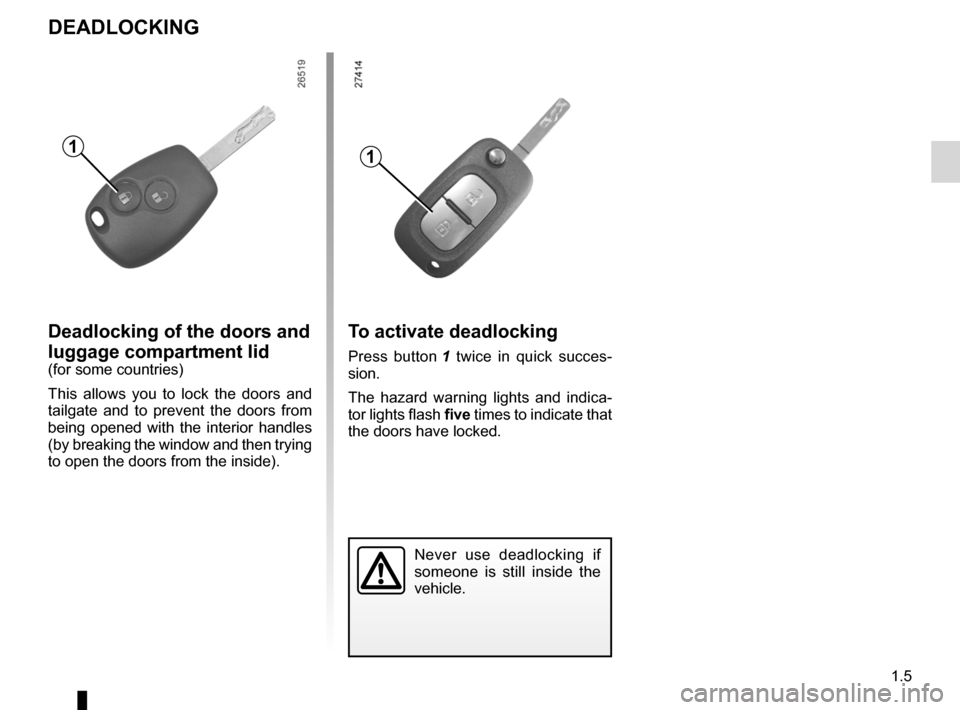
central door locking .............................. (up to the end of the DU)
locking the doors .................................. (up to the end of the DU)
1.5
ENG_UD15444_1
Super condamnation (E33 - X33 - Renault)
ENG_NU_865-6_E33_Renault_1
To activate deadlocking
Press button 1 twice in quick succes -
sion.
The hazard warning lights and indica -
tor lights flash five times to indicate that
the doors have locked.
DEADLOCKING
Deadlocking of the doors and
luggage compartment lid
(for some countries)
This allows you to lock the doors and
tailgate and to prevent the doors from
being opened with the interior handles
(by breaking the window and then trying
to open the doors from the inside).
Never use deadlocking if
someone is still inside the
vehicle.
11
Page 12 of 185
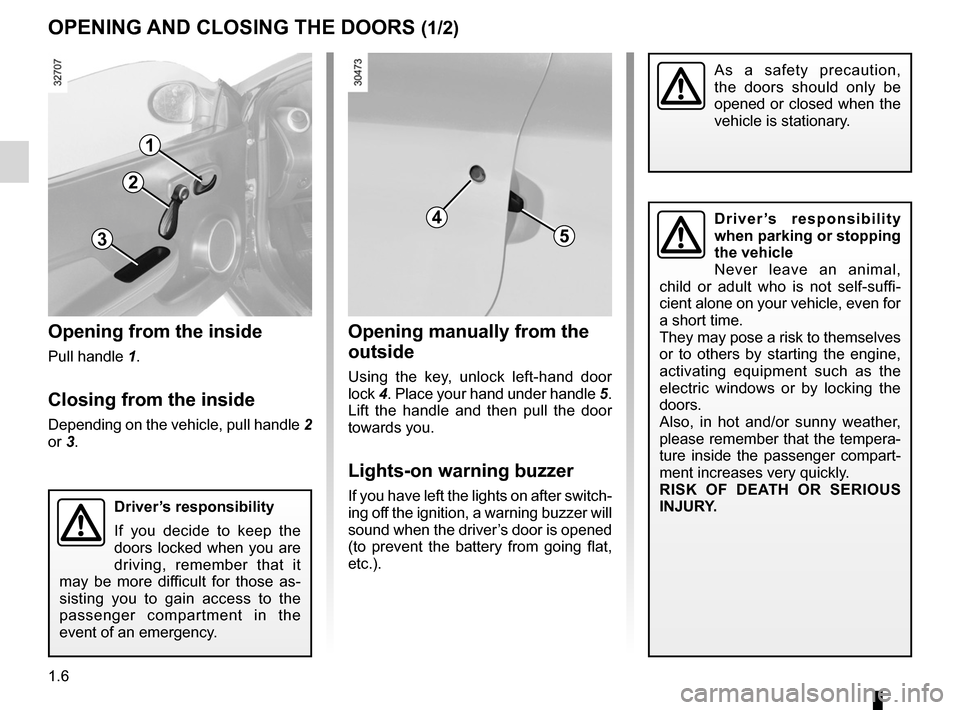
warning buzzer ...................................................... (current page)
doors ..................................................... (up to the end of the DU)
locking the doors .................................. (up to the end of the DU)
opening the doors ................................. (up to the end of the DU)
closing the doors .................................. (up to the end of the DU)
children ................................................. (up to the end of the DU)
doors/tailgate ........................................ (up to the end of the DU)
1.6
ENG_UD24353_3
Ouverture et fermeture des portes (E33 - X33 - Renault)
ENG_NU_865-6_E33_Renault_1
Jaune NoirNoir texte
Doors
Opening from the inside
Pull handle 1.
Closing from the inside
Depending on the vehicle, pull handle 2
or 3.
Driver’s responsibility
If you decide to keep the
doors locked when you are
driving, remember that it
may be more difficult for those as -
sisting you to gain access to the
passenger compartment in the
event of an emergency.
Opening manually from the
outside
Using the key, unlock left-hand door
lock 4. Place your hand under handle 5.
Lift the handle and then pull the door
towards you.
Lights-on warning buzzer
If you have left the lights on after switch-
ing off the ignition, a warning buzzer will
sound when the driver’s door is opened
(to prevent the battery from going flat,
etc.).
4
5
D r i v e r ’s r e s p o n s i b i l i t y
when parking or stopping
the vehicle
Never leave an animal,
child or adult who is not self-suffi -
cient alone on your vehicle, even for
a short time.
They may pose a risk to themselves
or to others by starting the engine,
activating equipment such as the
electric windows or by locking the
doors.
Also, in hot and/or sunny weather,
please remember that the tempera-
ture inside the passenger compart-
ment increases very quickly.
RISK OF DEATH OR SERIOUS
INJURY.
OpENING AND CLOSING THE DOORS (1/2)
As a safety precaution,
the doors should only be
opened or closed when the
vehicle is stationary.
1
2
3
Page 13 of 185

JauneNoirNoir texte
1.7
ENG_UD24353_3
Ouverture et fermeture des portes (E33 - X33 - Renault)
ENG_NU_865-6_E33_Renault_1
In the event of a fault with the
electric windows:
– The window does not lower when the
door is opened. If this happens, to
close the door, proceed as described
in the section entitled “In the event of
a battery fault”.
– The window does lower when the
door is opened but does not close
when the door is closed.
In these two cases, please refer to the
paragraph entitled “Electric windows”
in Section 3 to reinitialise the window
system.
If the problem persists after re-initial -
isation, please contact an authorised
dealer.
Every time one of the doors is
opened, the window lowers by a few
millimetres to facilitate door move -
ment. The window closes as soon
as the door is closed.
If there is any ice or snow prevent-
ing the window from lowering when
one of the doors is opened, this ice
or snow must be removed to free the
window before the door is closed.
If you need to disconnect the bat -
tery (breakdown etc.), lower the win-
dows to make handling the doors
easier whilst the battery is discon -
nected.
OpENING AND CLOSING THE DOORS (2/2)
Operating faults
In the event of a battery fault
With the vehicle unlocked:
– to open the door: lift handle 8, push
the top of window 7 then pull the
door gently towards you to prevent
damage to seal 6;
– to close the window: push the top
of the window (zone 7) while holding
the door to enable it to pass under
seal 6 , then close the door without
banging it.
Door locking is accompa -
nied by the windows clos -
ing.
Risk of serious injury.
Do not close the door by
holding the window.
Make sure you do not place
your fingers too high up in
zone 7.
Risk of injury.
8
76
Page 14 of 185
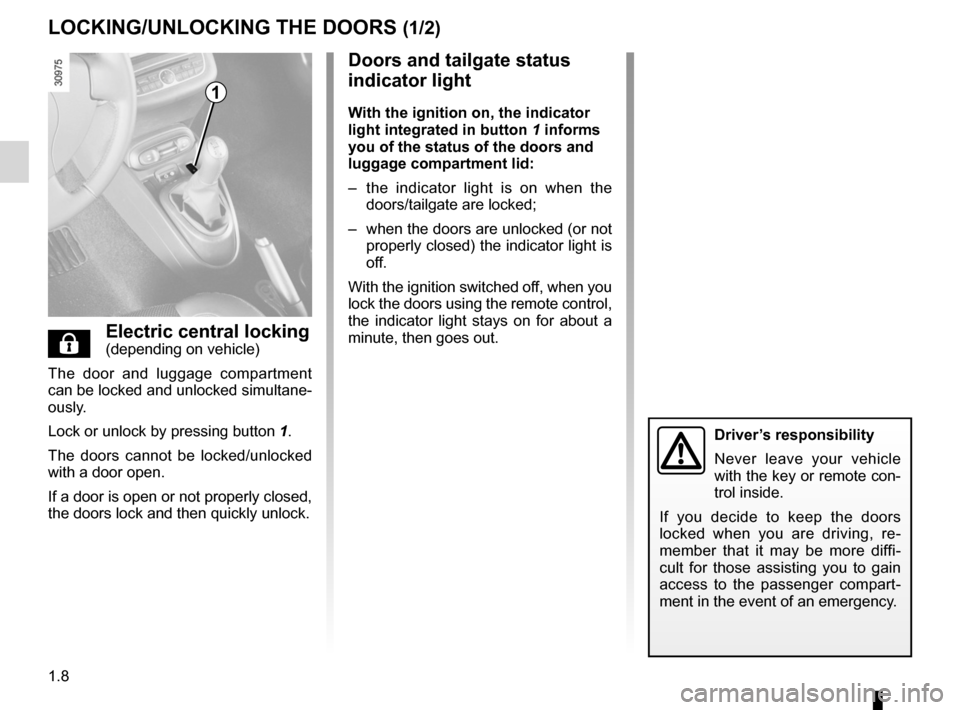
1.8
ENG_UD11151_1
Verrouillage / Déverrouillage des portes (E33 - X33 - Renault)
ENG_NU_865-6_E33_Renault_1
Jaune NoirNoir texte
SElectric central locking(depending on vehicle)
The door and luggage compartment
can be locked and unlocked simultane -
ously.
Lock or unlock by pressing button 1.
The doors cannot be locked/unlocked
with a door open.
If a door is open or not properly closed,
the doors lock and then quickly unlock.
Doors and tailgate status
indicator light
With the ignition on, the indicator
light integrated in button 1 informs
you of the status of the doors and
luggage compartment lid:
– the indicator light is on when the
doors/tailgate are locked;
– when the doors are unlocked (or not
properly closed) the indicator light is
off.
With the ignition switched off, when you
lock the doors using the remote control,
the indicator light stays on for about a
minute, then goes out.
LOCKING/UNLOCKING THE DOORS (1/2)
Driver’s responsibility
Never leave your vehicle
with the key or remote con-
trol inside.
If you decide to keep the doors
locked when you are driving, re -
member that it may be more diffi -
cult for those assisting you to gain
access to the passenger compart -
ment in the event of an emergency.
1
Page 15 of 185
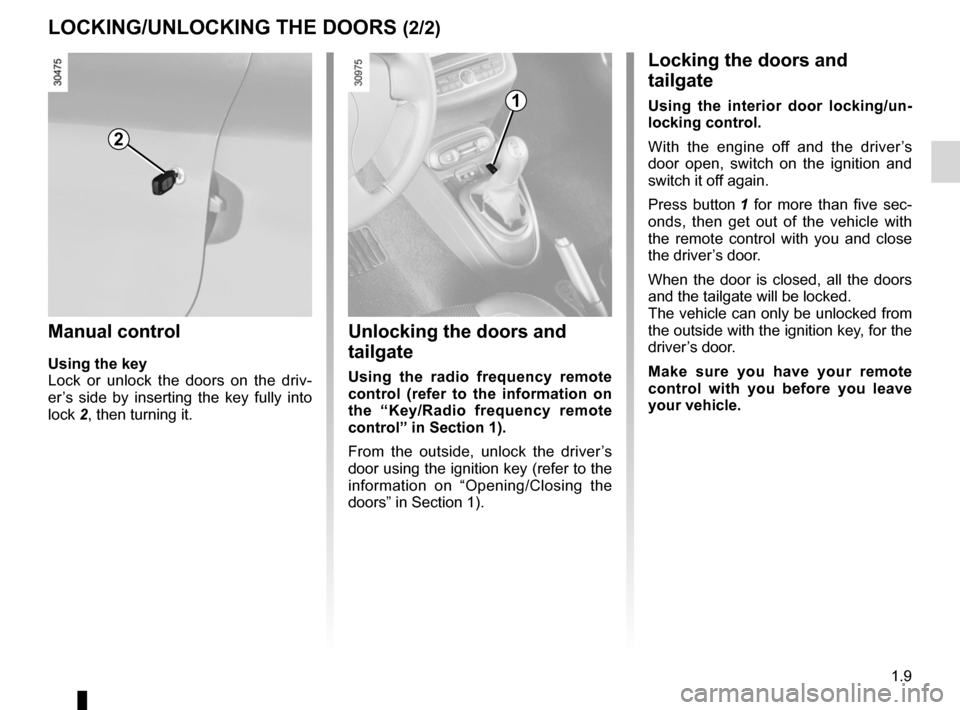
JauneNoirNoir texte
1.9
ENG_UD11151_1
Verrouillage / Déverrouillage des portes (E33 - X33 - Renault)
ENG_NU_865-6_E33_Renault_1
LOCKING/UNLOCKING THE DOORS (2/2)
Unlocking the doors and
tailgate
Using the radio frequency remote
control (refer to the information on
the “Key/Radio frequency remote
control” in Section 1).
From the outside, unlock the driver’s
door using the ignition key (refer to the
information on “Opening/Closing the
doors” in Section 1).
Manual control
Using the key
Lock or unlock the doors on the driv -
er’s side by inserting the key fully into
lock 2, then turning it.
2
Locking the doors and
tailgate
Using the interior door locking/un -
locking control.
With the engine off and the driver ’s
door open, switch on the ignition and
switch it off again.
Press button 1 for more than five sec -
onds, then get out of the vehicle with
the remote control with you and close
the driver’s door.
When the door is closed, all the doors
and the tailgate will be locked.
The vehicle can only be unlocked from
the outside with the ignition key, for the
driver’s door.
Make sure you have your remote
control with you before you leave
your vehicle.1
Page 16 of 185
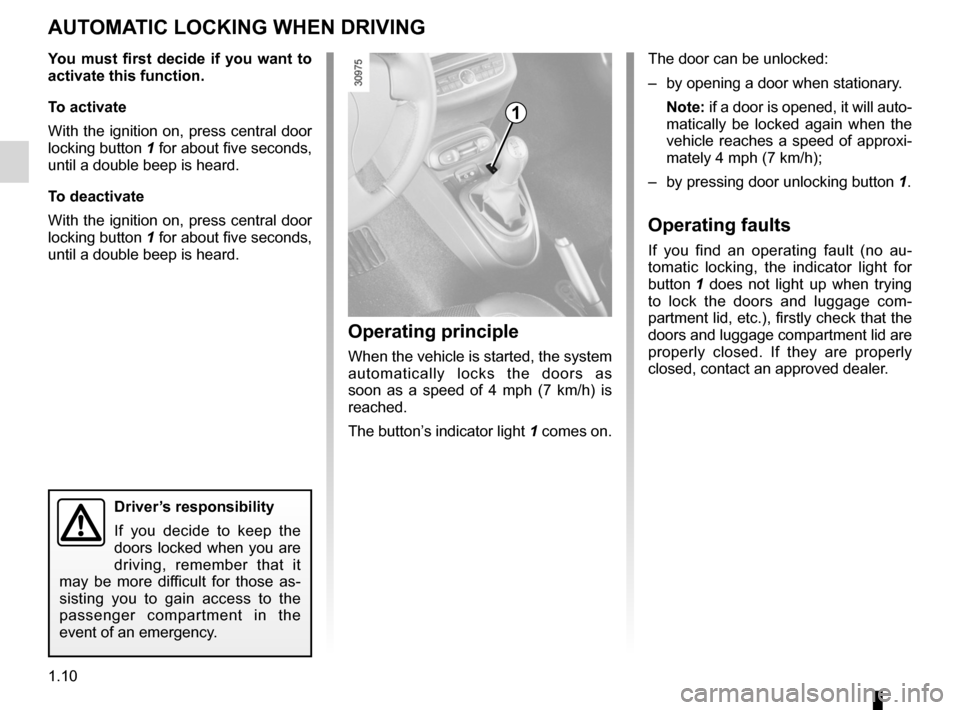
RENAULT ANTI-INTRUDER DEVICE (RAID) (up to the end of the DU)
central door locking .............................. (up to the end of the DU)
doors ..................................................... (up to the end of the DU)
locking the doors .................................. (up to the end of the DU)
doors/tailgate ........................................ (up to the end of the DU)
1.10
ENG_UD11152_1
Condamnation automatique des ouvrants en roulage (E33 - X33 - Renault)
ENG_NU_865-6_E33_Renault_1
Automatic locking when driving
AUTOMATIC LOCKING WHEN DRIVING
You must first decide if you want to
activate this function.
To activate
With the ignition on, press central door
locking button 1 for about five seconds,
until a double beep is heard.
To deactivate
With the ignition on, press central door
locking button 1 for about five seconds,
until a double beep is heard.
Driver’s responsibility
If you decide to keep the
doors locked when you are
driving, remember that it
may be more difficult for those as -
sisting you to gain access to the
passenger compartment in the
event of an emergency.
The door can be unlocked:
– by opening a door when stationary.
Note: if a door is opened, it will auto-
matically be locked again when the
vehicle reaches a speed of approxi -
mately 4 mph (7 km/h);
– by pressing door unlocking button 1.
Operating faults
If you find an operating fault (no au -
tomatic locking, the indicator light for
button 1 does not light up when trying
to lock the doors and luggage com -
partment lid, etc.), firstly check that the
doors and luggage compartment lid are
properly closed. If they are properly
closed, contact an approved dealer.
Operating principle
When the vehicle is started, the system
automatically locks the doors as
soon as a speed of 4 mph (7 km/h) is
reached.
The button’s indicator light 1 comes on.
1
Page 17 of 185
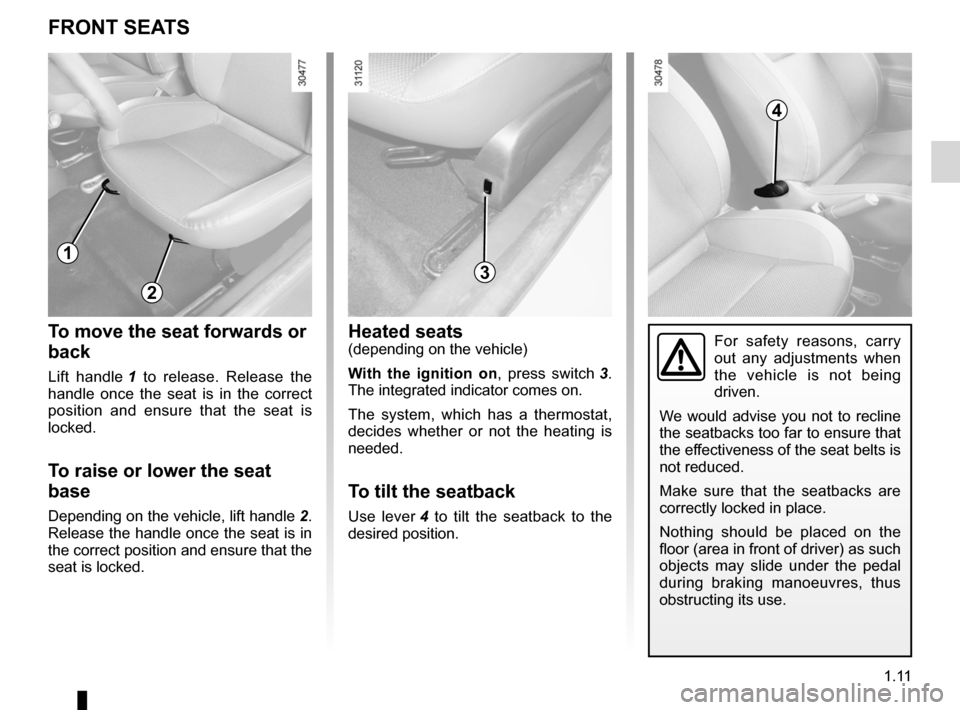
front seat adjustment ............................(up to the end of the DU)
front seats adjustment ...................................... (up to the end of the DU)
front seats with manual controls ........................................ (current page)
1.11
ENG_UD11155_1
Sièges avant à commandes manuelles (E33 - X33 - Renault)
ENG_NU_865-6_E33_Renault_1
Siège avant
To move the seat forwards or
back
Lift handle 1 to release. Release the
handle once the seat is in the correct
position and ensure that the seat is
locked.
To raise or lower the seat
base
Depending on the vehicle, lift handle 2.
Release the handle once the seat is in
the correct position and ensure that the
seat is locked.
For safety reasons, carry
out any adjustments when
the vehicle is not being
driven.
We would advise you not to recline
the seatbacks too far to ensure that
the effectiveness of the seat belts is
not reduced.
Make sure that the seatbacks are
correctly locked in place.
Nothing should be placed on the
floor (area in front of driver) as such
objects may slide under the pedal
during braking manoeuvres, thus
obstructing its use.
1
2
Heated seats(depending on the vehicle)
With the ignition on , press switch 3 .
The integrated indicator comes on.
The system, which has a thermostat,
decides whether or not the heating is
needed.
To tilt the seatback
Use lever 4 to tilt the seatback to the
desired position.
FRONT SEATS
4
3
Page 18 of 185
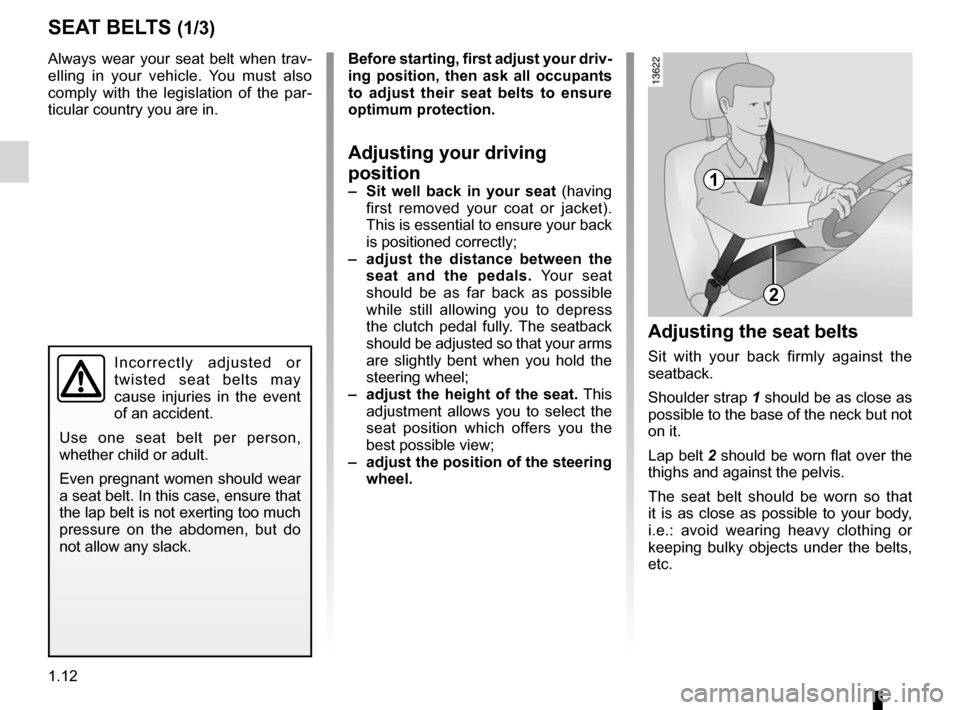
seat belts .............................................. (up to the end of the DU)
driving position settings ........................................... (up to the end of the DU)
adjusting your driving position ............................... (current page)
front seats adjustment ...................................... (up to the end of the DU)
1.12
ENG_UD25517_3
Ceintures de sécurité (E33 - X33 - Renault)
ENG_NU_865-6_E33_Renault_1
Jaune NoirNoir texte
Always wear your seat belt when trav-
elling in your vehicle. You must also
comply with the legislation of the par -
ticular country you are in.
Seat belts
Before starting, first adjust your driv-
ing position, then ask all occupants
to adjust their seat belts to ensure
optimum protection.
Adjusting your driving
position
– Sit well back in your seat (having
first removed your coat or jacket).
This is essential to ensure your back
is positioned correctly;
– adjust the distance between the
seat and the pedals. Your seat
should be as far back as possible
while still allowing you to depress
the clutch pedal fully. The seatback
should be adjusted so that your arms
are slightly bent when you hold the
steering wheel;
– adjust the height of the seat. This
adjustment allows you to select the
seat position which offers you the
best possible view;
– adjust the position of the steering
wheel.
Adjusting the seat belts
Sit with your back firmly against the
seatback.
Shoulder strap 1 should be as close as
possible to the base of the neck but not
on it.
Lap belt 2 should be worn flat over the
thighs and against the pelvis.
The seat belt should be worn so that
it is as close as possible to your body,
i.e.: avoid wearing heavy clothing or
keeping bulky objects under the belts,
etc.
SEAT BELTS (1/3)
1
2
I n c o r r e c t l y a d j u s t e d o r
twisted seat belts may
cause injuries in the event
of an accident.
Use one seat belt per person,
whether child or adult.
Even pregnant women should wear
a seat belt. In this case, ensure that
the lap belt is not exerting too much
pressure on the abdomen, but do
not allow any slack.
Page 19 of 185
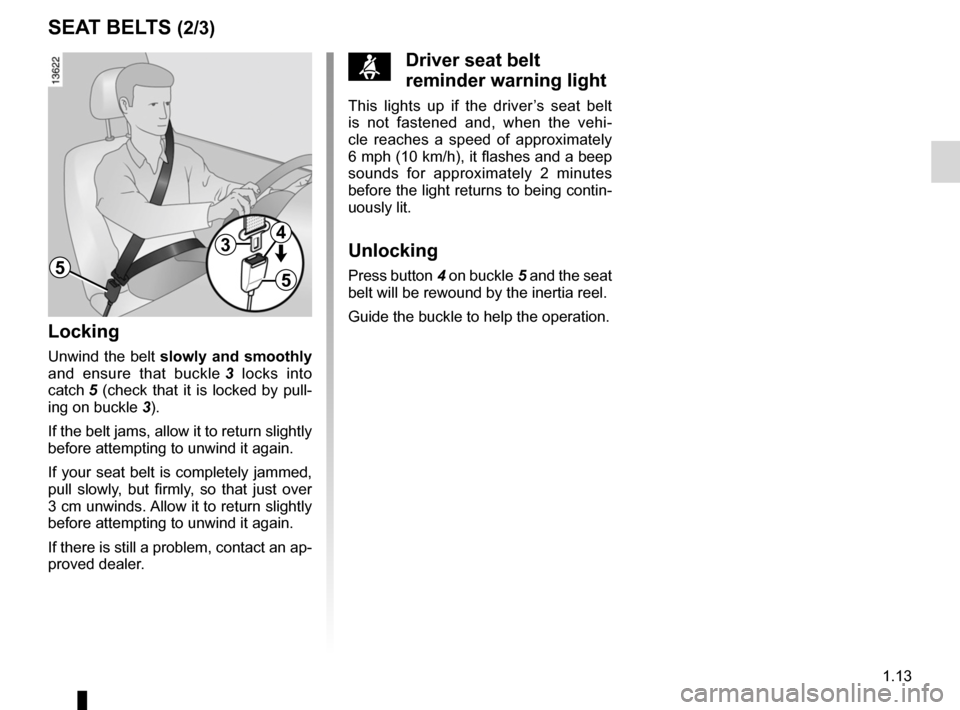
JauneNoirNoir texte
1.13
ENG_UD25517_3
Ceintures de sécurité (E33 - X33 - Renault)
ENG_NU_865-6_E33_Renault_1
SEAT BELTS (2/3)
5
34
5
Locking
Unwind the belt slowly and smoothly
and ensure that buckle 3 locks into
catch 5 (check that it is locked by pull -
ing on buckle 3).
If the belt jams, allow it to return slightly
before attempting to unwind it again.
If your seat belt is completely jammed,
pull slowly, but firmly, so that just over
3 cm unwinds. Allow it to return slightly
before attempting to unwind it again.
If there is still a problem, contact an ap-
proved dealer.
ßDriver seat belt
reminder warning light
This lights up if the driver’s seat belt
is not fastened and, when the vehi -
cle reaches a speed of approximately
6 mph (10 km/h), it flashes and a beep
sounds for approximately 2 minutes
before the light returns to being contin-
uously lit.
Unlocking
Press button 4 on buckle 5 and the seat
belt will be rewound by the inertia reel.
Guide the buckle to help the operation.
Page 20 of 185
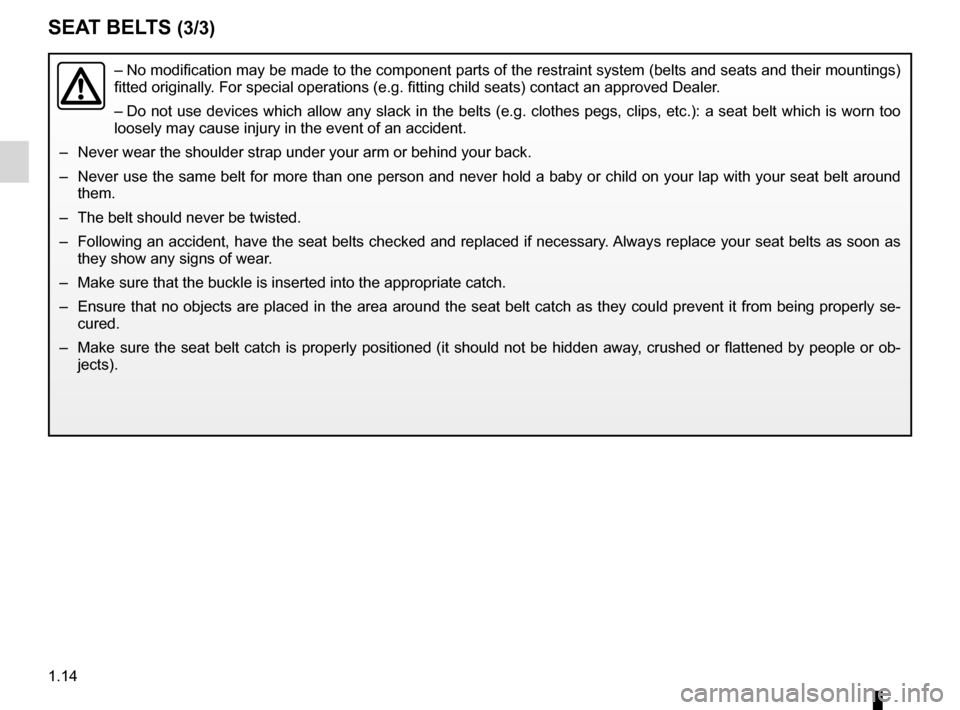
1.14
ENG_UD25517_3
Ceintures de sécurité (E33 - X33 - Renault)
ENG_NU_865-6_E33_Renault_1
SEAT BELTS (3/3)
– No modification may be made to the component parts of the restraint system (belts and seats and their mountings)
fitted originally. For special operations (e.g. fitting child seats) contact an approved Dealer.
– Do not use devices which allow any slack in the belts (e.g. clothes pegs, clips, etc.): a seat belt which is worn too
loosely may cause injury in the event of an accident.
– Never wear the shoulder strap under your arm or behind your back.
– Never use the same belt for more than one person and never hold a baby or child on your lap with your seat belt around
them.
– The belt should never be twisted.
– Following an accident, have the seat belts checked and replaced if necessary. Always replace your seat belts as soon as
they show any signs of wear.
– Make sure that the buckle is inserted into the appropriate catch.
– Ensure that no objects are placed in the area around the seat belt catch as they could prevent it from being properly se-
cured.
– Make sure the seat belt catch is properly positioned (it should not be hidden away, crushed or flattened by people or ob-
jects).